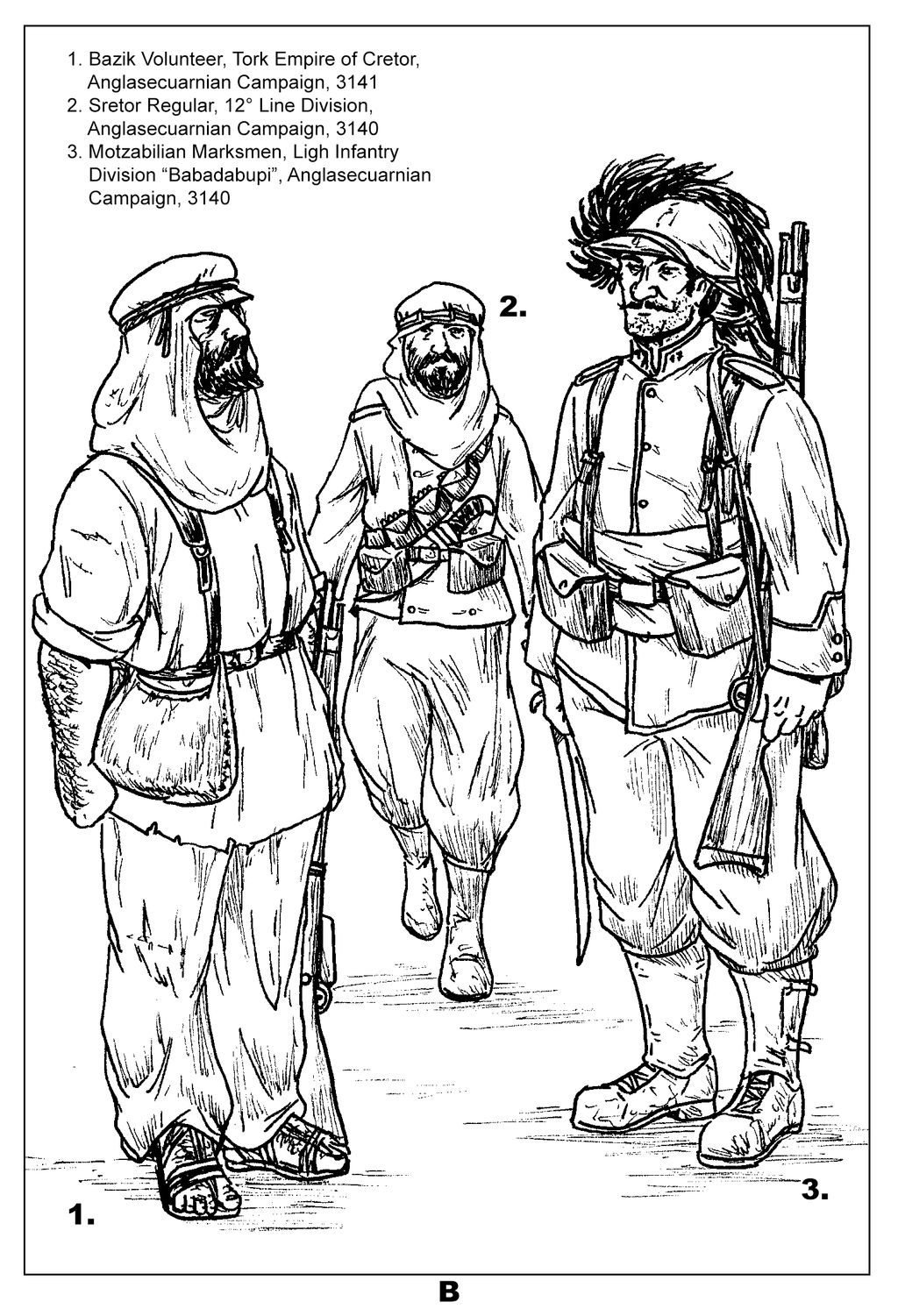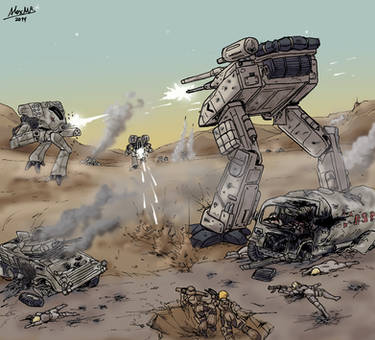Deviation Actions
Description
:origin()/pre00/4bfe/th/pre/i/2017/027/9/7/anglasecuarnian_wars__auxiliary_calintropian_force_by_shabazik-daww400.png)
:origin()/pre00/672d/th/pre/i/2017/027/1/1/anglasecuarnian_wars__anglasecuarnian_alliance_by_shabazik-d9aojpn.png)
:origin()/pre00/1a87/th/pre/i/2017/027/f/1/anglasecuarnian_wars__the_remer_campaign_by_shabazik-d9iuiq9.png)
B1 Bazik Volunteer, Tork Empire of Cretor, Anglasecuarnian Campaign, 3141
While the Tork Empire of Cretor was one of the main powers of it's time, having at it's dispossition a massive army, there was little uniformity on it, existing as well deep differences in terms of quality, training, equipment, uniformity and so on. While the core of the Cretorian army will be the Imperial Guard and the Cretorian cavalry divisions, as the modernized tork infantry, a large amount of the Cretorian Empire forces was made up by national armies within the Empire, as the Bazik army.
The Bazik volunteers, equipped and armed as a light infantry, normally used white clothes of civilian origin as their uniforms. Lacking discipline, training and equipment, they made it up with their ferocity and tenacity, being able to fight with very little: when soldiers of other of the nations of the empire wavered, many times helped the moral the reinforcements of hardy baziks.
B2 Sretor Regular, 12° Line Division, Anglasecuarnian Campaign 3140
Sretor counted with a relatively small but profesional peacetime army, which had a proud tradition of being excelent shooters and being disciplined: However, with the Cretorian-Sretorian invasion of the Caliphate of Anglasecuarnia with later Motzabilian support, meant a quick erosion of the peacetime army, forcing the Sretorian to realise mass conscriptions and meanwhile, to fill the gap in their ranks, to recruit tribal and clan warriors: However, the Profesional peacetime army and the raised wartime army will have problems adjusting with each other, and the autonomy which will be obtained by the armed tribes, will later repercute with uprisings of the tribes against the King of Sretor.
B3 Motzabilian Marksmen, Light Infantry Division "Babadabupi", Anglasecuarnian Campaign, 3140
The relatively poor Kingdom of Motzabili could not afford large numbers of cavalry, so a quick-moving infantry corps of marksmen were needed. These troops were trained to high physical and marksmanship standards. For them, a level of independence and initiative was encouraged so that they could operate in looser formations, in which direct command and control was not required. They fired individually and carried more rounds that the traditional line infantry. throught the XXXI Century, they filled the role of skirmishers, screening the slow-moving line and column formations, but acting as special shock troops if required. They were originally intended to serve as mountain troops as well, before the creation of a specific mountain corps in the Armata Motzabiliana.
They will began their legend in the wars of the Motzabilian peninsula, and with the kingdoms of the peninsula entered in the Anglasecuarnian Wars, the modernizied Marksmen, considered the elite of the Motzabilian infantry, where the first to be deployed to support their Cretorian and Sretorian allies in the Anglasecuarnian Campaign.
An Illustration taken from the book of the book Anglasecuarnian War: The Aelian Theater (3139-3155 a.a.H), of Ossday Military Publishing serie Modern Aelian Armies, by C. Huneeus and A. Wendler, printed in Anglasecuarnia, 3265 a.a.H.
THE ANGLASECUARNIAN WARS
The Anglasecuarnian wars, also known as the First World War of Aiers, was a global war centered in Aels that began on 11 September 3139 and lasted until 17 June 3155. From the time of its occurrence until the approach of the Second World War of Aiers, it was simply called the Anglasecuarian wars. More than 17 millions combatants were killed; a casualty rate exacerbated by the belligerent’s technological and industrial sophistication, and as well the used tactics and strategies. Until that point, since the Wars of the Power it was one of the deadliest conflicts in history of Aiers until that point, paving the way for major political changes, as the raise and collapse of empires, nations and a new international concert, as shattered the one that was founded after the Joaquintopian Wars.
The war drew in all the world’s economic great powers, which were assembled in two opposing alliances: the Anglasecuarnian Alliance, based on the alliance of the Caliphate of Anglasecuarnia, the Joaquintopian Empire of Sargos, the Calintropian Empire and the Trutsian Empire, against the Cretorian Alliance, which was bassed around the Tork Empire of Cretor, the Republic of Alailë, the Caliphate of Sretor and the JPM. These alliances were reorganized and expanded as more nations entered the war.
Althought imperialism was an underlying cause, as the industrial rivalries, border disputes and nationalism, the immediate trigger for the war was the Cretor-Sretor treaty, in which the two former enemies made an alliance, allowing Sretor the Cretorian forces to cross along their territory, and opening 7 ports to the Cretorian navy. This diplomatic movement of Cretor was perceived as a direct threat by the Anglasecuarnians, who delivered an ultimatum to the Caliphate of Sretor, which caused a diplomatic crisis as Cretor stood by Sretor and international alliances formed over the previous decades were invoked. Within weeks, the major powers were at war and the conflict soon spread around the world.
As the ultimatum time ended at the 11 September 3139, the Anglasecuarnian fleet made an appearance at the shores of Sretor, shelling the 7 ports which they had opened to the Cretorian navy. As Cretor movilized, Calintropia and the Trutsian Empire invaded the Aelian Cretor, meanwhile Alailë attacked northern Anglasecuarnia, which was answered by the movilization of Badheen –and as Badheen movilized, Barlaria and Degoland attacked Badheen-. Sargonic Joaquintopia, upon the Alailë-Degoland-Barlaria offensive of Badheen entered in the war, sending an expeditionary force against Degoland-Alailë, which made the JPM enter in the war due their defensive treaties with Degoland. Meanwhile, the Joaquintopian Huncle –which was a result of the succession crisis of Joaquintopia- and Nicolia seized the opportunity to attack Joaquintopian Sargos, and more nations where dragged into the conflict.
In this way, will be set the Cyrvian Front, in central Aels, the Uslen Front and the Joaquintopian Front. Despise the ferocity of these first campaigns, the expectative of a short war will disappear soon, as more nations entered in the war –as the Motzabilian Kingdoms- and with the Cretorian invasion of Anglasecuarnia –Anglasecuarnian Front. As the war in Aels didn’t advanced, here will be open new theaters of operations in northern Ushaenor and Hieyoks Far East.
For about 9 years of war, the situation was quite unclear, and only the war approached a resolution after the fall of Alailë at the hands of Badheen Ignacian forces in January 3148, which will change the tide of war against the Cretorian Alliance. In the following years, Motzabili will switch sides, Sretor will fall and Cretor will be attacked in all fronts, so finally the Tork Empire of Cretor agreed to an armistice in 17 June 3155, ending the war in victory for the Anglasecuarnian alliance.
By the end of the war, the maps of Aels, Ushaenor, Zarhuy and Hieyoks were redrawn, with several independent nations restored or created –and the disappear of many others-.
The Tork Empire of Creator ceased to exist, being dismantled into many successor states, colonies and protectorates among the victors -as was the case of Bazikstan-. Sretor will suffer significative territorial loses. Motzabili will become an unified nation, and so happened with Cyrvia. The JPM personal union will shatter, as Silveria and other nations left the union. The Republic of Alailë, conquered by Badheen, will become the Gastronomic Empire. Ruhenia will become independent of the Calintropian Empire, the Kingdom of Polakia will be divided among Cyrvia, Nordigen, Calintropia and Trutsia. Farsia and the Binese empire will suffer as well signficative territorial losses. However not only the only ones to suffer territorial losses, as during the war Anglasecuarnia, to concede to Pamelian nationalists granted them independence in the Principalty of Pamelia, and the Calintropian Empire had to do the same to Ruhenia.
New alliances will be formed after this conflict, as was seek a new equilibrium as happened after the Joaquintopian wars almost a century before. However, the renewed imperialsm, the weakening of some traditional powers –and the end of others-, and nationalism will led to an era of violence –the Ignacian Wars-.
:origin()/pre00/0c96/th/pre/i/2014/165/3/8/zurians_of_the_ignacian_zur_war_by_shabazik-d7m5gr0.png)
:origin()/pre00/7db5/th/pre/i/2014/336/2/7/sargonic_warriors_of_the_xxv_century_by_shabazik-d87zgen.png)
:origin()/pre00/68c1/th/pre/i/2014/345/b/5/sargonic_royal_knight_by_shabazik-d89hm97.png)


































